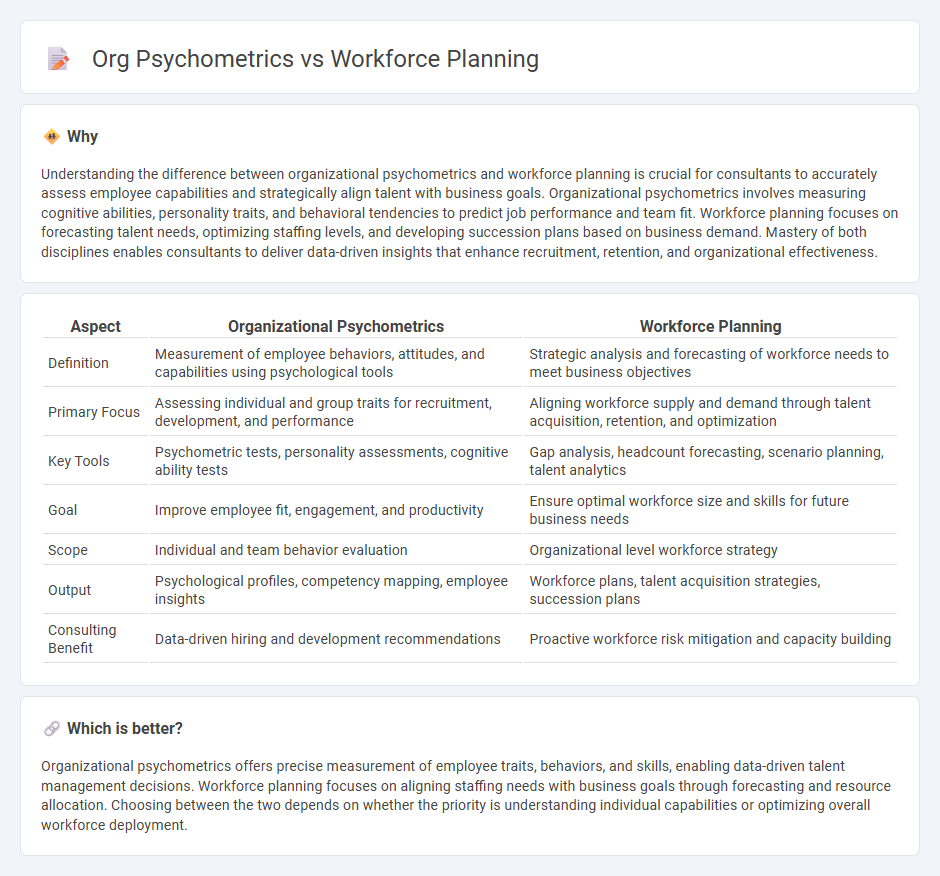
Organizational psychometrics leverages data-driven assessments to evaluate employee behavior, skills, and personality traits, enhancing talent management and leadership development. Workforce planning strategically forecasts staffing needs and allocates human resources to align with business goals and market trends. Explore how integrating psychometrics with workforce planning can transform organizational effectiveness.
Why it is important
Understanding the difference between organizational psychometrics and workforce planning is crucial for consultants to accurately assess employee capabilities and strategically align talent with business goals. Organizational psychometrics involves measuring cognitive abilities, personality traits, and behavioral tendencies to predict job performance and team fit. Workforce planning focuses on forecasting talent needs, optimizing staffing levels, and developing succession plans based on business demand. Mastery of both disciplines enables consultants to deliver data-driven insights that enhance recruitment, retention, and organizational effectiveness.
Comparison Table
| Aspect | Organizational Psychometrics | Workforce Planning |
|---|---|---|
| Definition | Measurement of employee behaviors, attitudes, and capabilities using psychological tools | Strategic analysis and forecasting of workforce needs to meet business objectives |
| Primary Focus | Assessing individual and group traits for recruitment, development, and performance | Aligning workforce supply and demand through talent acquisition, retention, and optimization |
| Key Tools | Psychometric tests, personality assessments, cognitive ability tests | Gap analysis, headcount forecasting, scenario planning, talent analytics |
| Goal | Improve employee fit, engagement, and productivity | Ensure optimal workforce size and skills for future business needs |
| Scope | Individual and team behavior evaluation | Organizational level workforce strategy |
| Output | Psychological profiles, competency mapping, employee insights | Workforce plans, talent acquisition strategies, succession plans |
| Consulting Benefit | Data-driven hiring and development recommendations | Proactive workforce risk mitigation and capacity building |
Which is better?
Organizational psychometrics offers precise measurement of employee traits, behaviors, and skills, enabling data-driven talent management decisions. Workforce planning focuses on aligning staffing needs with business goals through forecasting and resource allocation. Choosing between the two depends on whether the priority is understanding individual capabilities or optimizing overall workforce deployment.
Connection
Organizational psychometrics provides data-driven insights through assessments of employee abilities, personalities, and cultural fit, which are critical inputs for effective workforce planning. Workforce planning relies on these psychometric evaluations to forecast talent needs, identify skill gaps, and design strategic hiring or development programs aligned with organizational goals. Integrating psychometric analytics enhances decision-making accuracy in aligning human capital with future business demands.
Key Terms
Talent Analytics
Workforce planning integrates data-driven strategies to optimize talent acquisition, deployment, and retention, enhancing organizational efficiency. Organizational psychometrics employs psychological assessments to measure employee traits and behaviors, providing valuable insights for talent analytics and predictive workforce modeling. Explore how combining workforce planning with psychometric data enhances talent analytics for actionable decision-making.
Competency Frameworks
Workforce planning integrates competency frameworks to align skill sets with strategic business goals, enhancing talent acquisition and development processes. Organizational psychometrics uses validated assessments within competency frameworks to objectively measure employee behaviors, traits, and cognitive abilities, ensuring better cultural fit and performance prediction. Explore how combining workforce planning and psychometric insights optimizes competency frameworks for superior organizational outcomes.
Psychometric Assessment
Psychometric assessment plays a critical role in workforce planning by providing data-driven insights into employee personality traits, cognitive abilities, and behavioral tendencies. These assessments improve talent acquisition, employee development, and succession planning by aligning individual potential with organizational goals. Explore how integrating psychometric tools enhances strategic workforce decision-making and organizational performance.
Source and External Links
What Is Workforce Planning? Strategies and Benefits - Paychex - Workforce planning is the process of analyzing future staffing needs and developing strategies to meet those requirements by assessing your current workforce, forecasting future needs, identifying gaps, developing action plans, and continuously monitoring outcomes for organizational success.
Workforce Planning: Definition, Process and Principles | Indeed.com - Workforce planning, also called strategic workplace planning, involves analyzing, forecasting, and planning for workforce supply and demand by reviewing organizational objectives, conducting supply and demand analyses, and considering internal and external talent sources to align with business goals.
Workforce Planning - NIH: Office of Human Resources - Workforce planning is the process of analyzing, forecasting, and planning workforce supply and demand, identifying gaps, and determining targeted interventions to ensure the organization has the right people with the right skills in the right place at the right time to achieve strategic objectives.
 dowidth.com
dowidth.com